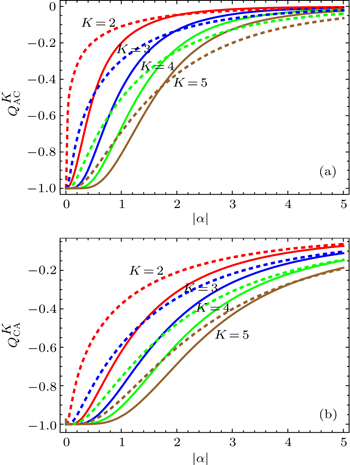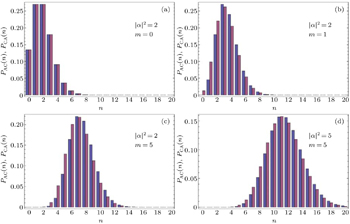† Corresponding author. E-mail:
Project supported by the National Natural Science Foundation of China (Grant Nos. 11447002 and 11447202), the Natural Science Foundation of Jiangxi Province of China (Grant No. 20151BAB202013), and the Research Foundation for Changzhou Institute of Modern Optoelectronic Technology of China (Grant No. CZGY15).
We explore two observable nonclassical properties of quantum states generated by repeatedly operating annihilation-then-creation (AC) and creation-then-annihilation (CA) on the coherent state, respectively, such as higher-order sub-Poissonian statistics and higher-order squeezing-enhanced effect. The corresponding analytical expressions are derived in detail depending on m. By numerically comparing those quantum properties, it is found that these states above have very different nonclassical properties and nonclassicality is exhibited more strongly after AC operation than after CA operation.
Gaussian states, such as coherent and squeezed states, play an important role in quantum optics and quantum information processing with continuous variables.[1] However, with rapid development in the area of quantum information theory, the de-Gaussification process has attracted much interest in order to overcome the limitations of Guassian light fields. De-Gaussification[2–4] can be realized in a simple manner by adding (subtracting) photons to (from) a Gaussian field and the resulting states are known to exhibit non-classical properties such as sub-Poissonian statistics,[5] higher-order squeezing,[6] antibunching,[7] and negativity of Wigner function.[8] The photon-added coherent state (PACS), first proposed by Agarwal and Tara,[9] was obtained by repeated application of the photon creation operator to the coherent state (CS) and exhibited highly nonclassical properties.[10] Briefly, a photon-added squeezed CS[11] was introduced and its nonclassical properties related to the coherent amplitude were discussed. Nha’s group has recently presented the coherent superposition of photon subtraction and addition,[12] ta + ra†, as well as other coherent superpositions of second-order operations,[13] ta2 + ra†2, for quantum state engineering. Particularly, they performed the coherent superposition on two-mode squeezed vacuum for enhancing quantum entanglement or non-Gaussian entanglement distillation.[14,15] Later, the generalized photon-added CS[16,17] was presented by repeatedly applying a† + a to the coherent state and the generalized photon modulated thermal state[18] was obtained by repeatedly acting ta + ra† on the thermal state.
In another development, much attention has been paid to the sequential operations, such as annihilation-then-creation a†a (AC) and creation-then-annihilation aa† (CA), on a given state. Among them, Yang and Li[19] also analyzed the operation ala†k and its inverse aka†l on an arbitrary state. Wang et al.[20] also investigated the nonclassicality generated by the operation ala†k on the CS. On the other hand, Lee’s group[21] investigated the properties of these states obtained by repeatedly applying (a†a)m and (aa†)m to the CS and thermal state, respectively. Very recently, our group also studied repeatedly applying (a†a)m and (aa†)m to the thermal state[22] and squeezed vacuum state[23] and compared their nonclassical and non-Gaussian properties. However, in Ref. [21], their discussion was restricted to study the single-photon ACCS and the corresponding Mandel Q factor. In the present paper, we focus our study on the higher-order nonclassical effects of two kinds of quantum states, denoted by MPACCS and MPCACS, generated by operating (a†a)m and (aa†)m on the CS, respectively. Due to the noncommutativity between creation and annihilation operator, these states generated by AC operation and CA operation have clearly different nonclassical properties. We first derive the analytical expressions of normalization factors, mean photon number, and photon number distribution (PND) of MPACCS and MPCACS, respectively. Next, two observable nonclassical properties are explored and numerically compared in terms of higher-order sub-Poissonian statistics and squeezing-enhanced effect. Particularly, we investigate how AC and CA operations affect those nonclassical properties. It is shown that their nonclassicality is exhibited more strongly after AC operation than after CA operation.
To begin with, let us introduce multiple-photon annihilation-then-creation coherent state (MPACCS) and multiple-photon creation-then-annihilation coherent state (MPCACS). Theoretically, MPACCS is obtained by repeated application of a†a to the coherent state, i.e.,




To fully describe two kinds of quantum states, we want to calculate the normalization constant 





We see from Eqs. (


For instance, according to 〈n〉 = Tr(a†aρ), from Eqs. (






According to Eqs. (
The sub-Poissonian statistics is a key characteristic of every optical field. We now examine the higher-order sub-Poissonian statistics of MPACCS and MPCACS in terms of factorial moment, which is defined by[25,26]

For the MPACCS, using Eqs. (









 | Fig. 2. Parameter QK of (a) |Ψ〉AC and (b) |Ψ〉CA as a function of |α| with m = 1 (solid line) and m = 5 (dashed line) for different values of K = 2,3,4,5, respectively. |
In Fig. 

As another example of the nonclassical effect, we explore how the squeezing quantitatively changes when AC and CA operations act on the coherent state. For this purpose, we consider the quadrature operator Xθ = aN e−iθ + a†N eiθ, and the squeezing is characterized by the minimum value[29] 〈:Δ2Xθ: 〉min < 0 with respect to θ, where : : denotes normal ordering, ΔO = O − 〈O〉 represents a quantum fluctuation, and θ is a phase angle. Upon expanding the terms of 〈: (ΔXθ) : 〉, one proposed the optimized nonclassical depth of squeezing Smin over the whole phases, which is given by[30]

In a similar way to derive Eqs. (





In summary, we introduce two kinds of quantum state (MPACCS and MPCACS) by repeatedly operating AC and CA operation on the CS and then numerically investigate their higher-order nonclassicality. Their normalization factors are analytically derived in compact expressions, where the former turns out to be the Bell-polynomial and the latter is related to Laguerre polynomial. Based on this, we also obtain mean photon number and photon number distribution of MPACCS and MPCACS, respectively. Furthermore, we shall explore their observable higher-order nonclassical properties such as higher-order sub-Poissonian statistics and higher-order squeezing-enhanced effect, which exhibits their highly nonclassical behaviors depending on m. By comparing their quantum characters, we conclude that the nonclassical states generated by AC operation can present stronger nonclassicality than those generated by CA operation.





